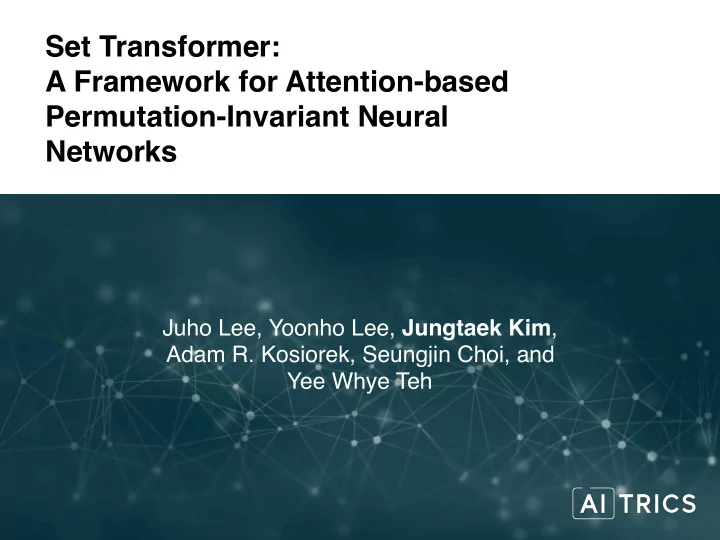

Set Transformer: A Framework for Attention-based Permutation-Invariant Neural Networks Juho Lee, Yoonho Lee, Jungtaek Kim , Adam R. Kosiorek, Seungjin Choi, and Yee Whye Teh
Set-input problems and Deep Sets [Zaheer et al., 2017] • Take sets (variable lengths, order does not matter) as inputs • Application includes multiple instance learning, point-cloud classification, few-shot image classification, etc. • Deep Sets: a simple way to construct permutation invariant set-input nerual networks, but does not effectively modeling interactions between elements in sets. f ( X ) = ρ ( ∑ ϕ ( x ) ) . x ∈ X
Attention based set operations • Use multihead self-attention [Vaswani et al., 2017] to encode interactions between elements in a set. X Y y ⊤ x ⊤ 1 1 y ⊤ x ⊤ XW q W ⊤ k Y ⊤ 2 Att( X , Y ) = softmax ( ) YW v . 2 ⋮ ⋮ y ⊤ x ⊤ m d n k ⊤ v ⊤ × 1 1 q ⊤ SelfAtt( X ) = Att( X , X ) . 1 k ⊤ v ⊤ × q ⊤ 2 2 2 ⋮ ⋮ ⋮ q ⊤ k ⊤ v ⊤ n × m m Q = XW q K = YW k V = YW v • Note that a self-attention is permutation equivariant , SelfAtt( π ⋅ X ) = π ⋅ SelfAtt( X )
Set transformer - building blocks • Multihead attention block (MAB): residual connection + multihead QKV attention followed by a feed-forward layer MAB( X , Y ) = FFN( WX + Att( X , Y )) . • Self attention block (SAB): MAB applied in self-attention way, O ( n 2 ) SAB( X ) = MAB( X , X ) . • Induced self-attention block (ISAB): introduce a set of trainable inducing O ( nm ) m points to simulate self-attention, with inducing points. ISAB( X ) = MAB( X , MAB( I , X )) . x ⊤ 1 i ⊤ h ⊤ 1 1 MAB( I , X ) x ⊤ = 2 ⋮ ⋮ o ⊤ ⋮ 1 i ⊤ h ⊤ m m o ⊤ x ⊤ = n 2 ⋮ o ⊤ x ⊤ n MAB( X , MAB( I , X )) 1 x ⊤ 2 ⋮ x ⊤ n
Set transformer - building blocks • Pooling by multihead attention (PMA): instead of a simple sum/max/min aggregation, use multihead attention to aggregate features into a single vector. • Introduce a trainable seed vector , and use it to produce one output vector. o = PMA 1 ( Z ) = MAB( s , Z ) • Use multiple seed vectors and apply self-attention to produce multiple interacting outputs (e.g., explaining away) S = [ s ⊤ 1 , …, s ⊤ O = SelfAtt(PMA k ( Z )) = SelfAtt(MAB( S , Z )) k ] .
Set transformer - architecture • Encoder: a stack of permutation-equivarinat ISABs. Z X z ⊤ x ⊤ 1 1 z ⊤ x ⊤ … ISAB 1 ISAB 2 ISAB L 2 2 ⋮ ⋮ z ⊤ x ⊤ n n • Decoder: PMA followed by self-attention to produce outputs. z ⊤ 1 o ⊤ 1 s ⊤ MAB( S , X ) z ⊤ 1 … SAB 1 ⋮ SAB L 2 ⋮ ⋮ o ⊤ s ⊤ k z ⊤ k n
Experiments • Amortized clustering - learn a mapping from dataset to clustering Deep Sets Set transformer
Experiments • Works well for various tasks such as unique character counting, amortized clustering, point cloud classification, and anomaly detection • Generalize well with small number of inducing points • Attentions both in encoder (ISAB) and decoder (PMA + SAB) are important for the performance.
Conclusion • New set-input neural network architecture • Can efficiently model pairwise/higher order interactions between elements in sets • Demonstrated to work well for various set-input tasks • Code available at https://github.com/juho-lee/set_transformer
References [Qi et al., 2017] Qi, R. C., Su, H., Mo, K., and Guibas, J. L. PointNet: Deep learning on point sets for 3D classification and segmentation. CVPR, 2017. [Vinyals et al., 2016] Vinyals, O., Blundell, C., Lillicrap, T., Kavukcuoglu, K., and Wierstra, D. Matching networks for one shot learning. NIPS, 2016. [Zaheer et al., 2017] Zaheer, M., Kottur, S., Ravanbhakhsh, S., Póczos, B., Salakhutdinov, R., and Smola, A. J. Deep sets. NIPS, 2017. [Wagstaff et al, 2019] Wagstaff, E., Fuchs, F. B., Engelcke, M., Posner, I., and Osborne, M. On the limitations of representing functions on sets. arXiv:1901.09006, 2019. [Cybenko 1989] Cybenko, G. Approximation by superpositions of sigmoidal functions. Mathematics of Control, Signals, and Systems, 2(4), 303314, 1989. [Shi et al., 2015] Shi, B., Bai, S., Zhou, Z., and Bai, X. DeepPano: deep panoramic representation for 3-D shape recognition. IEEE Signal Processing Letters, 22(12):2339–2343, 2015. [Su et al., 2015] Su, H., Maji, S., Kalogerakis, E., and Learned-Miller, E. Multi-view convolutional neural networks for 3d shape recognition. ICCV, 2015. [Snell et al., 2017] Snell, J., Swersky, K., and Zemel, R. Prototypical networks for few-shot learning. NIPS, 2017. [Ilse et al., 2018] Ilse, M., Tomczak, J. M., and Welling, M. Attention-based deep multiple instance learning. ICML, 2018. [Garnelo et al., 2018] Garnelo, M., Rosenbaum, D., Maddison, C. J., Ramalho, T., Saxton, D., Shanahan, M., Teh, Y. W., Rezende, D. J., and Eslami, S. M. A. ICML, 2018. [Vaswani et al., 2017] Vaswani, A., Shazeer, N., Parmar, N., Uszkoreit, J., Jones, L., Gomez, A. N., Kaiser, Ł ., and Polosukhin, I. Attention is all you need. NIPS, 2017.
Recommend
More recommend